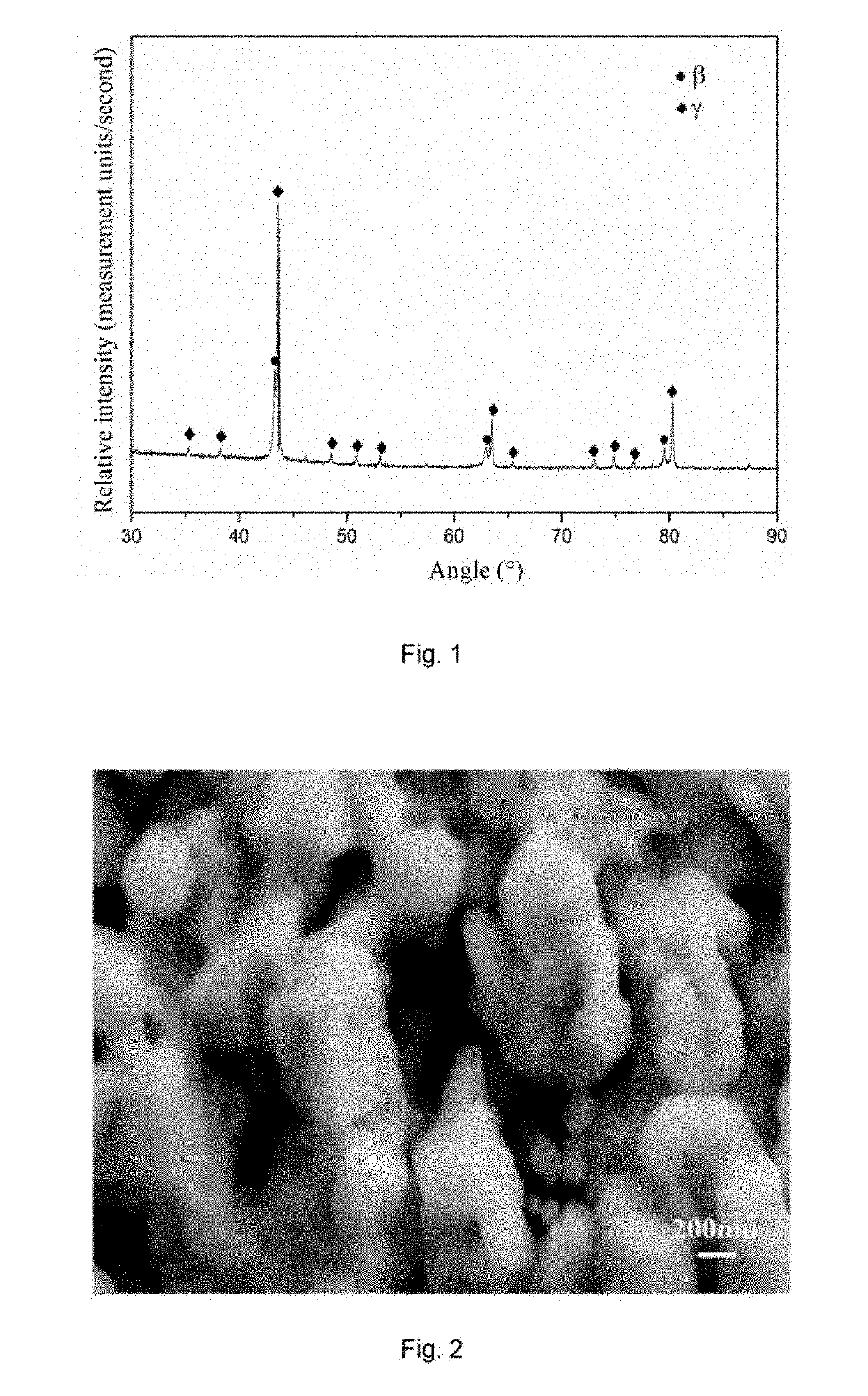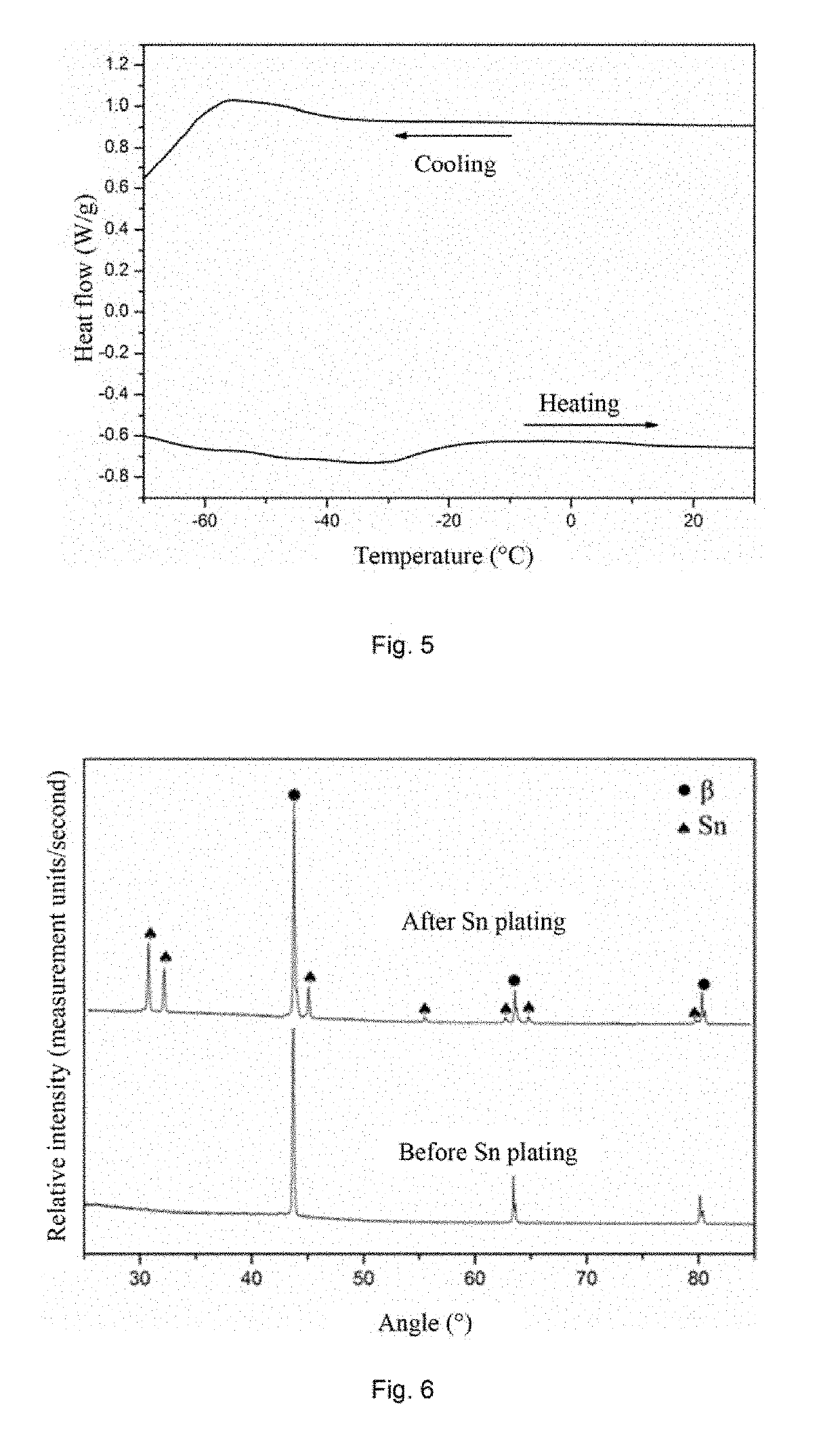Nanoporous Copper-Zinc-Aluminum Shape Memory Alloy and Preparation and Application Thereof
a technology of nanoporous copper zinc and memory alloy, applied in the field of nanoporous functional metal materials and lithium ion secondary batteries, can solve the problems of limited room for improvement, not much different theoretical capacities, and electrical materials, and achieves good superelasticity, effective alleviation of volume expansion, and high specific surface area
- Summary
- Abstract
- Description
- Claims
- Application Information
AI Technical Summary
Benefits of technology
Problems solved by technology
Method used
Image
Examples
embodiment 1
[0041](1) A pure copper block, a pure zinc block and a pure aluminum block are weighed according to a mass ratio of 60:34:6, and then are subjected to induction melting to obtain a copper-zinc-aluminum alloy ingot.
[0042](2) The copper-zinc-aluminum alloy ingot obtained in the step (1) is melt spun using a copper roller rapid quenching method under vacuum protection to obtain an ultrathin strip CuZnAl precursor having a γ phase (with characteristic peaks of 43.2, 62.7 and 79.2 degrees) and a small amount of β phase (with characteristic peaks of 43.5, 63.0 and 79.6 degrees), the XRD pattern of which is shown in FIG. 1. For the copper roller rapid quenching, the vacuum degree is 0.1 Pa, the rotational speed of the copper roller is 4000 rpm, the thickness of the strip is 20 μm, and the width of the material is 5 mm.
[0043](3) The ultrathin strip CuZnAl master alloy having both β and γ phases which is obtained in the step (2) is etched in an aqueous solution of ferric chloride hydrochlori...
embodiment 2
[0047](1) A pure copper block, a pure zinc block and a pure aluminum block are weighed according to a mass ratio of 61:32:7, and then are subjected to induction melting to obtain is a copper-zinc-aluminum alloy ingot.
[0048](2) The copper-zinc-aluminum alloy ingot obtained in the step (1) is melt spun using a copper roller rapid quenching method under vacuum protection to obtain an ultrathin strip CuZnAl master alloy having a γ phase and a small amount of β phase. For the copper roller rapid quenching, the vacuum degree is 1 Pa, the rotational speed of the copper roller is 3000 rpm, the thickness of the strip is 40 μm, and the width of the material is 10 mm.
[0049](3) The ultrathin strip CuZnAl master alloy having both β and γ phases which is obtained in the step (2) is etched in an alcohol solution with a chloride ion concentration of 3% at a temperature of 80° C. for 240 min.
[0050](4) The porous Cu / CuZnAl composite material with nanometer-scale pore sizes which is obtained in the st...
embodiment 3
[0051](1) A pure copper block, a pure zinc block and a pure aluminum block are weighed according to a mass ratio of 60:35:5, and then are subjected to arc melting to obtain a copper-zinc-aluminum alloy ingot.
[0052](2) The copper-zinc-aluminum alloy ingot obtained in the step (1) is melt spun using a copper roller rapid quenching method under vacuum protection to obtain an ultrathin strip CuZnAl master alloy having a γ phase and a small amount of β phase. For the copper roller rapid quenching, the vacuum degree is 0.5 Pa, the rotational speed of the copper roller is 2000 rpm, the thickness of the strip is 60 μm, and the width of the material is 3 mm.
[0053](3) The ultrathin strip CuZnAl master alloy having both β and γ phases which is obtained in the step (2) is etched in an aqueous hydrochloric acid solution having a chloride ion concentration of 1 wt. % at a temperature of 50° C. for 120 min to obtain a nanoporous Cu / CuZnAl composite material.
[0054](4) The porous Cu / CuZnAl composite...
PUM
| Property | Measurement | Unit |
|---|---|---|
| Temperature | aaaaa | aaaaa |
| Temperature | aaaaa | aaaaa |
| Fraction | aaaaa | aaaaa |
Abstract
Description
Claims
Application Information
 Login to View More
Login to View More - R&D
- Intellectual Property
- Life Sciences
- Materials
- Tech Scout
- Unparalleled Data Quality
- Higher Quality Content
- 60% Fewer Hallucinations
Browse by: Latest US Patents, China's latest patents, Technical Efficacy Thesaurus, Application Domain, Technology Topic, Popular Technical Reports.
© 2025 PatSnap. All rights reserved.Legal|Privacy policy|Modern Slavery Act Transparency Statement|Sitemap|About US| Contact US: help@patsnap.com



